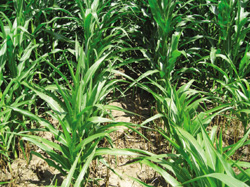
Features
Agronomy
Cereals
Pea residues increase soil organic matter
The benefits of pulse crops include the nitrogen (N) contribution to subsequent rotational non-legume crops, but researchers are finding that the N contribution is far less than previously believed. Research by Agriculture and Agri-Food Canada soil microbiologist Dr. Newton Lupwayi at Lethbridge, Alberta is pointing to some of the reasons why, by looking at the N release during decomposition of pea residue.
February 25, 2010 By Bruce Barker
 |
|
| Residue from pea crops do not release a large amount of N to the subsequent crop. Photo courtesy of Rick Taillieu.
|
The benefits of pulse crops include the nitrogen (N) contribution to subsequent rotational non-legume crops, but researchers are finding that the N contribution is far less than previously believed. Research by Agriculture and Agri-Food Canada soil microbiologist Dr. Newton Lupwayi at Lethbridge, Alberta is pointing to some of the reasons why, by looking at the N release during decomposition of pea residue. “The N contribution of pea residue is less than that of legume green manures because most of the N in pulse crops is removed with grain at harvest,” explains Lupwayi.
Lupwayi explains that the N in crop residues is mostly in organic forms like proteins and amino sugars. In these forms, the N is not available to crops and must be mineralized, where soil microbes convert unavailable organic N into mineral forms of N that are available to the plant for uptake. Soil microbial activity is influenced by soil moisture and temperature. The rate of N mineralization is generally greater in warmer and wetter ecosystems than in colder and drier ecosystems.
In his field trial, Lupwayi used the litter-bag method to measure N loss from clover green manure (GM), field pea, canola and wheat residues under conventional and zero-till.
At harvest time, crop residues, proportional to their yields, were placed in 30cm x 30cm plastic litter bags with a one-millimeter mesh. The bags were either buried five centimetres below the soil surface in conventional tillage or placed on the surface in zero tillage.
Seven bags (corresponding to seven sampling times) were laid in each plot. One bag was retrieved from each plot periodically during a 52-week period to determine N still remaining in the residues, and the N lost (mineralized) was estimated by the difference from the initial amount of residue N.
In the trial, Lupwayi found that the legume green manure crop residue contributed the most N to the soil, and had the most mineralization as well, ranging from 40 to 78 percent of the added N. Pea residue contributed much less, a maximum of 30 percent of its N was released, less than canola but more than wheat residue.
To put the N release rates into perspective, a 40 bu/ac wheat crop grown the following year requires 95 kg of N per hectare (85 lbs of N per acre). The legume GM residue could supply 48 to 73 percent of the N requirement of the wheat, pea residue up to 19 percent, canola residue up to 26 percent and wheat residue only up to two percent.

|
|
 |
Why not as much N from pea crops?
One of the reasons is that most of the nitrogen that is fixed by the pea crop is exported off the field in the seed. By the time a pea crop is harvested, the amount of N in the residue represent about 14 to 20 percent of the total N with 80 to 86 percent found in the seed.
Another reason is related to crop residue quality, as measured by the N, carbon and lignin concentrations. Higher residue N concentration usually results in higher net N mineralization. The C:N ratio is negatively correlated with net N mineralization, so a higher C:N ratio results in less net N mineralization. Lignin concentration (or lignin:N ratio) is also negatively correlated with net N mineralization.
Lupwayi explains that soil microorganisms need N (and other nutrients) for their metabolism, and C and lignin not only dilute the concentrations of these nutrients in crop residues, lignin also resists decomposition.
The actual amounts of N released from crop residue did not differ significantly between tillage systems, and there were no interactions between tillage and sampling time. Because much less than one-half of the N in pea, canola and wheat residue was released in the 52-week period after harvest, Lupwayi says that the N is not lost but is still stored in the residue organic matter, and will be available for mineralization in subsequent years. “There is a need to follow N release patterns for periods longer than one year to find out how much N is released in subsequent years,” says Lupwayi. A project that follows N release over a three-year period is currently underway.